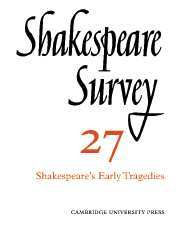Book contents
- Frontmatter
- Shakespeare’s Earliest Tragedies: ‘Titus Andronicus’ and ‘Romeo and Juliet’
- The Aesthetics of Mutilation in ‘Titus Andronicus’
- The Motif of Psychic Division in ‘Richard III’
- The Antic Disposition of Richard II
- The Prince of Denmark and Claudius’s Court
- ‘Hamlet’ and the ‘Moriae Encomium’
- The Relation of Henry V to Tamburlaine
- Shakespeare and the Puritan Dynamic
- Equity, ‘The Merchant of Venice’ and William Lambarde
- ‘Love’s Labour’s Won’ and the Occasion of ‘Much Ado’
- The Date and Production of ‘Timon’ Reconsidered
- Shakespeare, Her Majesty’s Players and Pembroke’s Men
- Judi dench talks to Gareth Lloyd Evans
- Shakespeare Straight and Crooked: A Review of the 1973 Season at Stratford
- The Year's Contributions to Shakespearian Study 1 Critical Studies
- 2 Shakespeare’s Life, Times, and Stage
- 3 Textual Studies
- Index
- Plate section
‘Hamlet’ and the ‘Moriae Encomium’
Published online by Cambridge University Press: 28 March 2007
- Frontmatter
- Shakespeare’s Earliest Tragedies: ‘Titus Andronicus’ and ‘Romeo and Juliet’
- The Aesthetics of Mutilation in ‘Titus Andronicus’
- The Motif of Psychic Division in ‘Richard III’
- The Antic Disposition of Richard II
- The Prince of Denmark and Claudius’s Court
- ‘Hamlet’ and the ‘Moriae Encomium’
- The Relation of Henry V to Tamburlaine
- Shakespeare and the Puritan Dynamic
- Equity, ‘The Merchant of Venice’ and William Lambarde
- ‘Love’s Labour’s Won’ and the Occasion of ‘Much Ado’
- The Date and Production of ‘Timon’ Reconsidered
- Shakespeare, Her Majesty’s Players and Pembroke’s Men
- Judi dench talks to Gareth Lloyd Evans
- Shakespeare Straight and Crooked: A Review of the 1973 Season at Stratford
- The Year's Contributions to Shakespearian Study 1 Critical Studies
- 2 Shakespeare’s Life, Times, and Stage
- 3 Textual Studies
- Index
- Plate section
Summary
Perhaps the most impressive feature of Shakespeare’s Hamlet is the way he has managed to transform a crude Norseman of the heroic age into a Renaissance prince of such impressive presence. Speculation about how it was done has led commentators a merry dance through sixteenth-century history and ideas. The place of Erasmus there, which no one familiar with the century would wish to dispute, has not really been taken into sufficient account in such speculation, considering first, how inescapable his influence was in general, and second, how much evidence there is in the plays that Shakespeare was familiar with his work — and especially with the Moriae Encomium. Positive proof of first-hand acquaintance has, of course, been lacking; but circumstantial evidence is of sufficient weight to command attention. The Moriae Encomium was a grammar-school text in the 1570s and 1580s, and it is perfectly possible that Shakespeare knew it as early as that, having perhaps been set to translate it himself. Schoolboys who were able to get hold of a copy must have been tempted to consult the Chaloner translation as a crib (it was first published in 1549, with subsequent editions in about 1560 and 1577); but there is, of course, no reason to think that Shakespeare did, though in later years he may well have known it. Whatever the truth of that, his acquaintance with the Moriae Encomium is supported by a wide range of what seem to be direct echoes of not only its thinking, but also its illustrative material. To mention only a few of the more obvious which have drawn notice.
- Type
- Chapter
- Information
- Shakespeare Survey , pp. 59 - 70Publisher: Cambridge University PressPrint publication year: 1974



